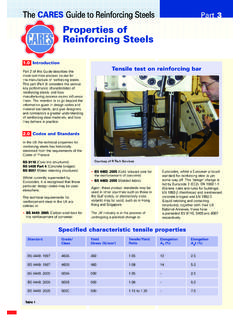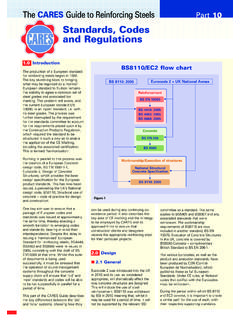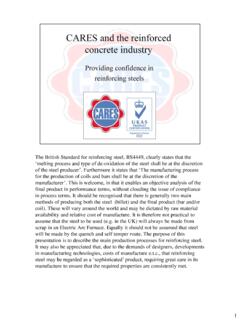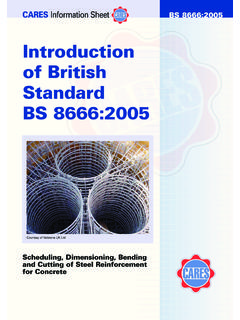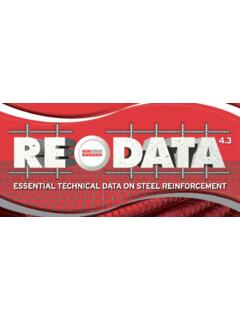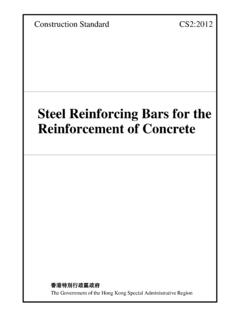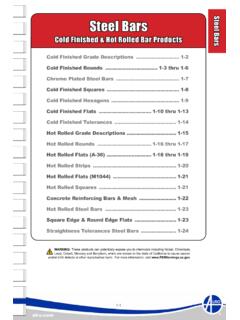Transcription of Properties of Reinforcing Steels - UK CARES
1 The CARES Guide to Reinforcing Steels Part 3. Properties of Reinforcing Steels Introduction Part 2 of this Guide describes the Tensile test on Reinforcing bar most common process routes for the manufacture of Reinforcing Steels . This part (Part 3) considers the various key performance characteristics of Reinforcing Steels , and how manufacturing process routes influence them. The intention is to go beyond the information given in design codes and material standards, and give designers and contractors a greater understanding of Reinforcing steel materials, and how they behave in practice.
2 Codes and Standards In the UK the technical Properties for Reinforcing Steels has historically stemmed from the requirements of the Codes of Practice: BS 8110 (Concrete structures) Courtesy of R-Tech Services BS 5400 Part 4 (Concrete bridges). BS 8007 (Water retaining structures) BS 4482: 2005 (Cold reduced wire for Eurocodes, whilst a European product the reinforcement of concrete) standard for Reinforcing steel is yet Whilst currently superseded by BS 4483: 2005 (Welded fabric) some way off. This design' change is Eurocodes, it is recognised that these led by Eurocode 2 (EC2); EN 1992-1-1.
3 Particular design codes may be used Again, these product standards may be (General rules and rules for buildings), elsewhere. used in other countries such as those in EN 1992-2 (Reinforced and prestressed The technical requirements for the Gulf states, or alternatively close concrete bridges) and EN 1992-3. reinforcement steel in the UK are variants may be used, such as in Hong (Liquid retaining and containing defined in: Kong and Singapore. structures); together with their UK. National Annexes, these have BS 4449: 2005 (Carbon steel bars for The UK industry is in the process of superseded BS 8110, 5400 and 8007.)
4 The reinforcement of concrete) undergoing a practical change to respectively. Specified characteristic tensile Properties Standard Grade/ Yield Tensile/Yield Elongation Elongation Class Stress (N/mm2) Ratio A5 (%) Agt (%). BS 4449: 1997 460A 460 12 BS 4449: 1997 460B 460 14 BS 4449: 2005 500A 500 - BS 4449: 2005 500B 500 - BS 4449: 2005 500C 500 to - Table 1. Linked to the introduction of the new Fatigue yield strength ratio (Rm/Re), and the codes will be the new European elongation, (BS4449:1997 - both at Bond Standard for Reinforcing Steels , EN fracture (A5) and at maximum load (Agt).
5 10080, although the date of Weldability (chemical composition) and BS4449;2005 only at maximum publication of this standard remains load (Agt.) The symbols used in EC2 for uncertain. The British Standards, BS these Properties are ft/fy and u 4449, BS 4482 and BS 4483 remain in respectively. practical use and were revised in Tensile Properties 2005 in order to align with the Figure 1 shows a stress-strain curve for requirements of EC2 and the UK Table 1 shows the specified a Reinforcing bar produced by the National Annex.
6 In revision, these characteristic tensile Properties which quench and self tempered process standards fit within the requirements are currently specified in BS 4449. It route (QST). The various tensile described for Reinforcing steel in the should be noted that the 1997 and 2005 parameters are defined in the figure. relative Eurocodes. revisions of BS4449 are referenced, as both are still in use globally, although it Yield strength can be defined in several Part 10 of this Guide will cover these seems that the use of BS4449:2005 is different ways.
7 Where Steels show a changes in more detail, and include increasing. In BS4449:1997, the Yield so-called yield effect , as in the their relationship with the Strength is specified as both a example in Figure 1, the standards Construction Products Regulations minimum, and a characteristic value, allow the yield strength to be and CE marking. whilst in BS4449:2005, this determined as the upper yield strength. 'characteristics' applies both to the This is the point on the stress-strain Properties of Yield Strength and curve where the load initially drops; the Elongation.
8 In the case of Properties manufacturing, this means that the upper yield point. Alternatively, the yield strength can be defined as the stress at manufacturer must demonstrate long- The main performance characteristics a permanent strain of (Figure 1);. term statistical compliance, as well as required of Reinforcing Steels may be the proof strength. In some achieving the required test results on categorised as follows: Steels , for example cold worked Steels , each individual batch. no yield effect is observed, the stress- Tensile strength, including yield strain plot showing a continuous It is also worth noting that BS4449 and strength and elongation curve after the linear elastic portion BS4482 describe ductility in terms of (Figure 2).
9 In these Steels , yield Bend/rebend two parameters; the tensile strength to strength is always defined as the proof strength. Stress-strain curve of a QST bar The tensile strength/yield strength ratio (Rm/Re) is a measure of a steel 's ability 700. to work harden prior to fracture, and Rm hence is also used as a measure of the ductility of the steel . 600. Re Uniform elongation (Agt) is also a measure of a Steels ability to deform 500. Rp prior to fracture. It should be noted that in the European design codes and also Stress (MPa).
10 The draft European product standard, 400 uniform elongation replaces elongation to fracture (A5), which has been the measure of ductility in British Standards 300. to date. Agt is deemed to be a more appropriate design characteristic. 200. In general terms, there is an inverse relationship between strength and ductility. However this is strongly 100 influenced by the steel manufacturing process route. 0. 0 5 10 15. Agt 20. A5. 25. Figure 2 shows the stress-strain curves Strain (%) for four common types of Reinforcing steel and demonstrates the differences Figure 1 Courtesy of R-Tech Services in tensile behaviour between the different types: Stress-strain curves of different types of steel 800.
